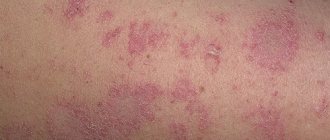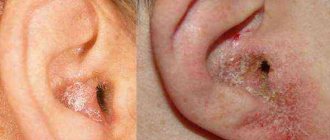Causes
Many things can cause a rash on your stomach. Some of the most common reasons include the following:
Cellulitis (skin infection)
Cellulitis (bacterial infection)
This is not about fat deposits, but about purulent inflammation under the skin, which is also called cellulite in medicine. This type of rash is caused by bacteria - staphylococci or streptococci - entering the fatty tissue. The rash is red, painful, warm, tender and swollen; there may also be blisters or dimples. They can also spread surprisingly quickly, and one of the most characteristic symptoms is that the rash changes shape or otherwise grows.
Lyme disease
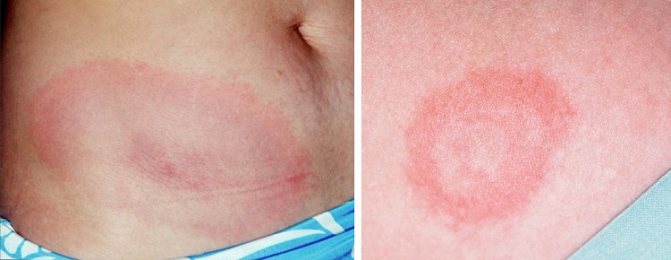
This rash is caused by a tick bite and is usually a bacterial infection that can begin a month or so after the bite itself. This rash is not painful and is more pronounced closer to the center of the redness, resembling a bull's eye." Associated symptoms are similar to the flu, such as fever, chills, fatigue and aches.
Dermatitis herpetiformis

Dermatitis herpetiformis is a chronic autoimmune condition characterized by intensely itchy blisters filled with watery fluid. It is a cutaneous manifestation of celiac disease ( gluten intolerance ). Despite the name, dermatitis herpetiformis is not associated with or caused by the herpes virus: the name means that it is an inflammation of the skin, similar to herpes.
Dermatitis herpetiformis is often confused with other rashes such as drug rash (a reaction to medications), contact dermatitis, and even scabies.
Treatment is a strict gluten-free diet, which is usually required for life.
Atopic dermatitis
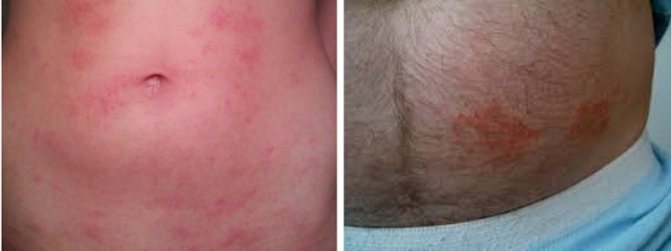
Atopic dermatitis, also known as eczema, often appears as itchy skin that can sometimes be red and dry with small bumps. Although this condition usually occurs on the face and limbs, it can also occur on the abdomen. The causes of atopic dermatitis (eczema) are thought to be related to genetics and environmental factors such as dry weather.
Contact dermatitis

This is the body's reaction to exposure to irritating or allergic substances. Examples of triggers include poison ivy, soap, cosmetics, clothing fabrics, laundry detergents, and other things that are harsh on the skin or cause an allergic reaction. Accordingly, contact dermatitis can be irritant or allergic.
So, when a rash appears on your stomach, try to remember if you have recently started using a new skin care product, soap or laundry detergent.
Psoriasis
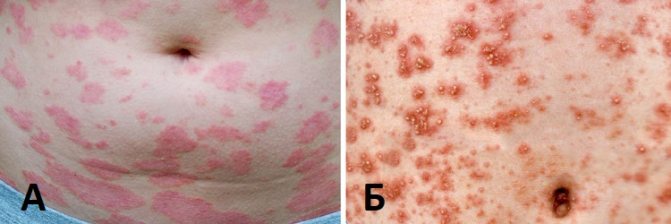
This is an autoimmune disease in which there is excessive growth of skin cells. Some of the common characteristics include red, blotchy skin covered in silvery scales that will appear and disappear in a cyclical manner, and each episode may persist for several weeks or several months in some cases.
Another common characteristic of psoriasis is dry skin that cracks and if it itches or burns, bleeding may occur, especially when the patches are picked off.
Chicken pox

Chickenpox (chickenpox) is a contagious infection that can have serious consequences in adults compared to young children. The disease will produce red or pink bumps that become blisters (filled with fluid) and once they burst, scabs will form.
Other symptoms may include headache, fever, malaise and decreased appetite. To prevent the spread of chickenpox, it must be isolated until the scabs (crusts) formed from the rupture blisters have completely disappeared.
Shingles

This disease occurs due to the reactivation of the varicella zoster virus in the body in people who have previously had it. Usually, headaches, poor health and skin pain in the area where the rash appears a few days later begin. It initially appears as red spots and only on one side of the body. The spots become itchy blisters that ooze fluid. After a few days, the blisters dry out and crust over.
It takes up to 4 weeks for the rash to go away. But pain in that place may persist for several more weeks. Shingles cannot be spread to another person, but the virus in the oozing fluid can cause chickenpox (chickenpox) in people who have not previously had it. Therefore, you should stay at home and avoid contact with other people until the rash crusts over.
Pityriasis rosea
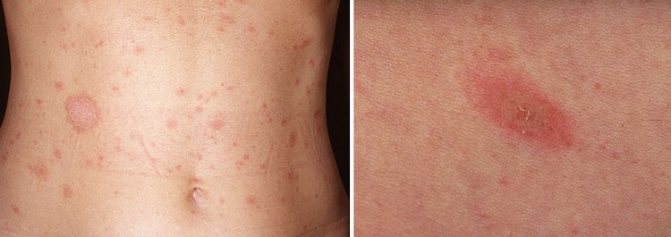
is a small, itchy and scaly rash that usually appears first as a single spot on the chest, abdomen or back. After this initial appearance, the rash may spread in small patches to other parts of the back, chest, and neck.
Diaper rash
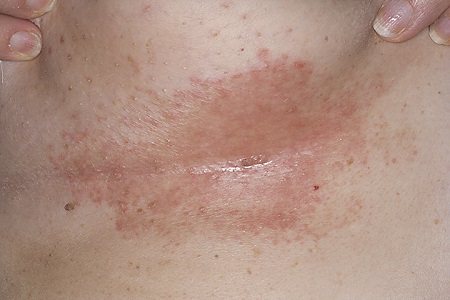
This condition is caused by skin friction and often occurs in warm, moist places on the body such as skin folds, including the abdomen, under the breasts, groin, armpits, inner thighs, and between the toes.
The affected skin will tend to be sore and sensitive. In extreme cases, expect to experience bleeding, broken skin, and sores that ooze.
Diseases of unknown etiology
In medical practice, there are often cases when a patient is diagnosed with diseases, the cause of which is not possible to determine. For example, this:
- Eczema. The specificity of the symptoms does not allow this pathology to be confused with any other. As a rule, the lesion is in the form of vesicles and covers large areas of the skin. In addition to the fact that the rash on the stomach of an adult itches, there is also swelling of the tissues and their redness. Painful cracks, dry dermis, and lack of elasticity are often disturbing, even after the main symptoms have disappeared.
- Psoriasis. The rash appears where there is close contact with clothing, for example, around the waistband of trousers. It looks like a group of plaques with gray scales. Beneath this surface, if you try to open it, there is a thin layer of skin. Upon contact with a rough object, the plaque scales easily peel off, and the lower layer of the dermis begins to bleed.
Rash on the stomach and back
A rash in the abdominal area can have many possible causes, including allergens, infections, autoimmune disorders, or other causes such as stress. Below are some reasons that can simultaneously cause rashes on the back:
Pityriasis rosea . This can form a pattern on the back that resembles the outline of a Christmas tree. This condition usually goes away without treatment in 4-10 weeks, but can last for several months.
Drug rash. Usually appears as a side effect of a medication or an allergic reaction to it. This rash can be caused by many different medications, including antibiotics and diuretics.
Swimmer's itch (cercariasis) . It appears as an itchy or burning rash that can appear anywhere, including the abdomen, caused by an allergic reaction to parasite larvae found in bodies of water and burrowing into the upper layers of the skin.
Although the larvae subsequently die, you will be left with a rash with small blisters or bumps.
Other causes of a rash appearing on the back and stomach at the same time may include:
- chicken pox or shingles;
- erythema nodosum;
- measles, mumps, rubella, roseola and scarlet fever;
- rheumatoid arthritis;
- extreme cold or heat;
- stress.
Folk remedies
Using traditional medicine to treat rashes in the abdominal area sometimes helps better than pharmaceutical medications. Some plants help speed up wound healing, smooth the skin and relieve inflammation. To combat itching and minor rashes, you can use the following remedies:
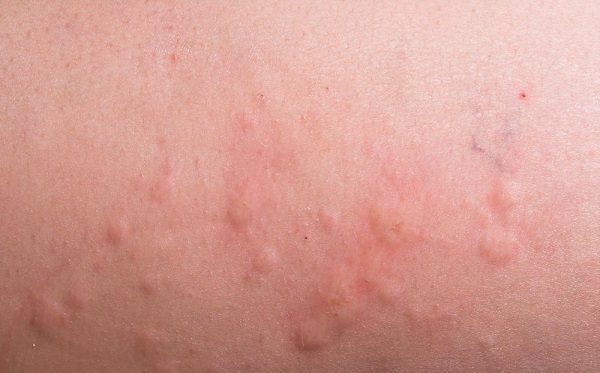
Ointment made from celandine juice and vegetable oil. Mix both components and apply regularly to the wound.- A few spoons of sea salt in the bath will help relieve inflammation and also have a disinfectant effect.
- You can reduce the sensation of burning and itching with the help of soda lotions.
- Ointment made from sea buckthorn oil and calendula flowers. Mix the ingredients and add baby creams or internal fat to make the mass homogeneous. This remedy can treat urticaria and similar diseases.
Thus, rashes on the abdomen can be of different types, shapes, colors, and can also occur for various reasons in men and women. If visible symptoms are detected, it is recommended to contact a highly qualified specialist for diagnosis and assistance in treatment.
Rash on the abdomen after surgery
“According to the World Allergy Organization, allergies to the anesthesia a patient receives sometimes cause skin rashes after surgery. The skin may also become swollen and red in patches due to irritation of the blood vessels.”
reference.com
Fortunately, these rashes go away on their own. Additionally, people under the age of 6 or over 65 are more vulnerable to allergic reactions after surgery. This is due to the fact that the metabolism of those under 6 years of age has not yet developed enough, and after 65 years of age, similar functions of removing drugs from the body begin to decline.
Main symptoms
If a rash of any type appears on the stomach, including without itching, it is necessary to determine its origin. This can only be done by specialists - a pediatrician for children, a therapist or a dermatologist.
In addition to the type of skin manifestations, the causes can be identified by a number of other symptoms:
- the presence of itching, swelling, hyperemia;
- general condition of the body;
- temperature rise;
- the presence of other types of allergic reactions.
It should be remembered that rashes accompany many infectious and general diseases, in particular:
- rubella;
- chickenpox;
- sexual infections;
- infection with the herpes virus;
- allergies;
- helminth infection;
- gastrointestinal pathologies;
- scarlet fever;
- cardiovascular pathologies.
The specialist determines the cause by the nature of the skin rashes and changes in the body’s condition. Therefore, before going to the doctor, you need to remember everything that preceded the onset of manifestations - eating a new type of food, contacts with patients, and much more.
Most types of rashes in adults are associated with allergic reactions to various substances.
Video about allergies:
Rash on belly during pregnancy

Is the skin on the abdomen covered with itchy bumps? A belly rash during pregnancy may begin on the abdomen in an area with stretch marks, which may be itchy. This condition is known as pruritic urticarial papules and plaques of pregnancy or multiform dermatosis of pregnancy .
The red rash is lumpy and bumpy, similar to hives. Sometimes if the rash is scratched, a small amount of fluid will ooze out and then crust over.
This rash is not considered dangerous to you or your baby. However, in some rare cases, a newborn may develop a mild skin rash that will disappear soon.
On the stomach and chest
There can be many causes for a breast rash, and it may indicate something going on in the breast itself, or it may suggest a systemic (body-wide) condition. Chest rashes have many possible causes, including allergens (allergy-causing agents), infections, autoimmune disorders, or other causes such as stress.
Here are some of the reasons:
- ectasia of the mammary glands;
- mastitis (infection or inflammation of the breast);
- fungal infections (especially Candida Albicans fungi).
Rash on baby's stomach and/or back
Children are constantly exposed to various illnesses and irritants that can cause rashes. They are usually benign, but can cause discomfort to the child and anxiety to the parents.
It is important to identify the rash and any other accompanying symptoms to try to identify potentially serious causes that may require treatment.
Here are the most common:
- prickly heat;
- insect bites;
- contact dermatitis;
- viral infections;
- eczema;
- hives.
In the abdomen and groin area
The appearance of an itchy rash in the groin is as common as itching on the body. For most, this is a temporary problem that goes away quickly. But itching in the groin is often more problematic than in other parts of the body, mainly because of its social component.
There are many different causes of itchy groin rashes. These include:
- personal hygiene;
- exposure to irritants;
- skin infections and sexually transmitted infections;
- parasitic infestations;
- psoriasis of the groin area, especially inverse psoriasis (psoriasis of the flexor surfaces).
- contact dermatitis.
Pimples
Why does your back and other parts of the body itch and pimples appear? The reason for this may be a malfunction of the sebaceous glands. Subcutaneous fat clogs the pores, resulting in inflammation and acne.
Also, similar phenomena appear when problems arise in the gastrointestinal tract and digestion processes.
Diseases of the endocrine system can also cause an itchy back and pimples to appear on the skin.
In any of these cases, consultation with a doctor is necessary. Self-medication here can only worsen the situation.
On the navel
A rash that occurs in and around the belly button can be caused by infection or moisture. Allergies can also cause it when you use products that contain metal or other substances that are allergens to your skin, including an allergic reaction or navel piercing infection.
An infection in the belly button (omphalitis) can also cause a rash. For example, this can occur after things such as lint, hair, or other forms of debris get into it, which is accompanied by an inflammatory reaction, itching and discharge.
Psoriasis is a skin condition that can appear in the navel area, causing red, hard patches to appear.
Pemphigoid gestation is another possible rare cause of belly button rash. This is an autoimmune disease that affects women. The body's immune system reacts to its own skin, causing blisters to form.
Diagnostics

When carrying out diagnostic procedures, the person’s age and gender, predisposition to hereditary forms of diseases, the presence of children of kindergarten age, as well as general well-being are taken into account. A well-collected anamnesis from the patient’s words facilitates diagnostic measures. The patient’s field of activity is of great importance, since workers in certain professions experience characteristic symptoms. For example, veterinarians and livestock farm workers experience dermatitis associated with parasites or pathogenic flora characteristic of a particular animal species.
If people often travel to exotic countries, they may bring a disease that is not typical for that region. In this case, it is necessary to find out what exactly got into the human body and whether there is a need for quarantine.
To identify the cause of the rash, a dermatologist conducts a survey, then prescribes laboratory tests, including those that show how the immune system reacts to various substances.
Genetic testing allows us to determine to what extent the disease is related to hereditary factors. This is an expensive procedure, but it makes it possible to decide on treatment.
Treatment Options
Here are some tips and treatments that may be helpful for certain types of rashes:
Don't comb
It is normal to have the urge to scratch the rash. But avoid scratching your belly as this can damage your skin and leave it open to other infections. Additionally, it will affect your healing rate. Try antihistamines, an oatmeal or baking soda bath, or calamine lotion to soothe the itching.
Skin hydration
Victims of psoriasis and eczema must keep their skin moisturized to prevent it from drying out and therefore cracking. Also, try cool compresses and use a humidifier.







